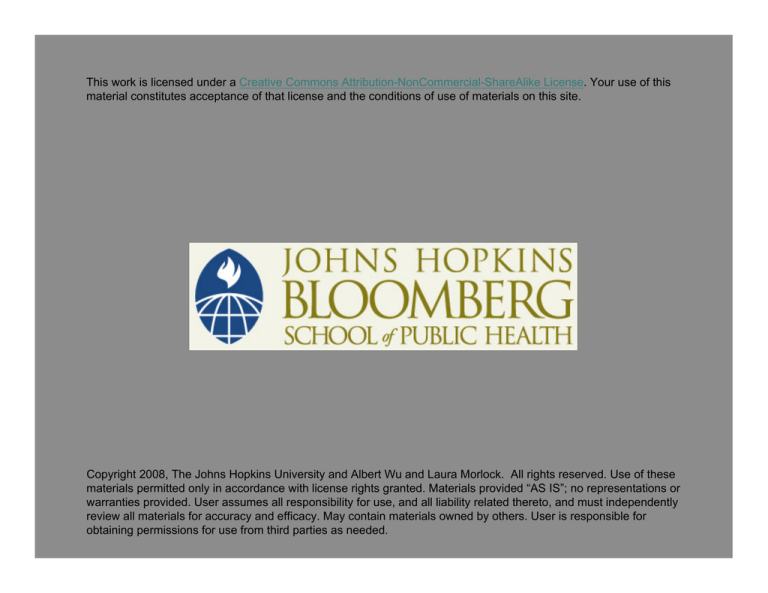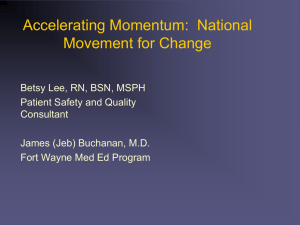
This work is licensed under a Creative Commons Attribution-NonCommercial-ShareAlike License. Your use of this
material constitutes acceptance of that license and the conditions of use of materials on this site.
Copyright 2008, The Johns Hopkins University and Albert Wu and Laura Morlock. All rights reserved. Use of these
materials permitted only in accordance with license rights granted. Materials provided “AS IS”; no representations or
warranties provided. User assumes all responsibility for use, and all liability related thereto, and must independently
review all materials for accuracy and efficacy. May contain materials owned by others. User is responsible for
obtaining permissions for use from third parties as needed.
Adverse Events and Safety in Health Care: Concepts
and Definitions
Albert Wu, MD, MPH
Laura Morlock, PhD, MA
Johns Hopkins University
Case
Patient underwent wound debridement
Surgeon ordered stat antibiotic
The patient had a penicillin allergy
Difficulty communicating with pharmacy for stat medications
Nurse borrowed antibiotic from another patient to shorten
time to first dose
Antibiotic was administered
Anaphylactic reaction
3
Two Viewpoints on Human Error
1.
2.
The person (active failure) approach: Focus on acts and
omissions by individuals
The system (latent failure) approach: Traces causal factors
back to the system as a whole
Source: James Reason. (1990).
4
Reason—Complex Systems
Organizational
& corporate
culture
Contributor
factors affecting
clinical practice
Care
management
problems
Defense
barriers
Error-producing
conditions
Management
decisions &
organizational
processes
Latent
conditions
Errors
Violationproducing
conditions
Violations
Triggering
factors
Unsafe acts or
omissions
Source: Adapted from James Reason. (1990).
Accident
Accident
Incident
Incident
Defense
Defense
barriers
barriers
5
Definitions
Error
Adverse event
Near miss
Caveat
6
Definition Diagram
ERROR
NEAR MISS
ADVERSE
EVENT
HARM
7
Error
The failure of a planned action to be completed as intended
(i.e., error of execution) and the use of a wrong plan to
achieve an aim (i.e., error of planning)
Also includes failure of an unplanned action that should have
been completed (omission)
Refer to processes of care
8
Definition Diagram: Error
ERROR
9
Iatrogenic injury
Injury originating from or caused by a physician (iatros, Greek
for “physician”), including unintended or unnecessary harm
or suffering arising from any aspect of health care
management, including problems arising from acts of
commission or omission
“Harm” generally refers to outcomes or results
10
Definition Diagram: Harm
HARM
11
Adverse Event
An event that results in unintended harm to the patient by an
act of commission or omission rather than by the underlying
disease or condition of the patient
“Preventable harm”
Both “preventable” and “unpreventable” are evolving
concepts
12
Definition Diagram: Overlap
ERROR
ADVERSE
EVENT
HARM
13
Near Miss
An error of commission or omission that could have harmed
the patient, but serious harm did not occur as a result of
chance (e.g., the patient received a contraindicated drug but
did not experience an adverse drug reaction); prevention
(e.g., a potentially lethal overdose was prescribed, but a nurse
identified the error before administering the medication); or
mitigation (e.g., a lethal drug overdose was administered but
discovered early and countered with an antidote)
14
Definition Diagram: Near Miss
ERROR
NEAR MISS
ADVERSE
EVENT
HARM
15
Patient Safety
The prevention of harm caused by errors of commission and
omission
16
Summary
Clarification of concepts and definitions illustrated by case
study
17






